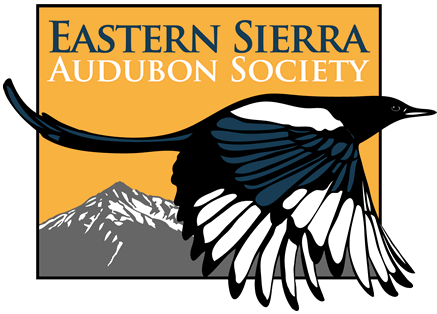This years IMBD dawned windless and beautiful, far from the day-long gale last years hardy teams withstood. From dawn until almost dusk thirty-five observers covered the Owens Valley, White Mountains, and eastern Sierra canyons, vacuuming with their eyes and ears for all the birds they could find. The goal of the day was to see how many different species of birds could be seen in one day as well as how many individual birds are using our area as they migrate to their breeding grounds. Some interesting statistics from this years count: 182 different species were found (up 2 from last year and a new record) totaling over 10,340 individual birds (up 3240 from last year and another new record); of the 182 species 139 were neotropical migrants (up 5 from last year and another new record). Neotropical migrants are birds who spend the winter in Mexico, Central and South America and the Caribbean and migrate north to breed in North America.
The most common bird was the Cliff Swallow (594) followed closely by the European Starling (535), just the opposite from last year when Starlings barely outnumbered Cliff Swallows. About 241 observer hours were recorded, which is like one observer looking for birds for 241 hours or over 10 straight days and nights! Nine species seen this year were new to the count as they were not seen the last two years bringing the total species seen during IMBDs to 210, a remarkable number for a county without an ocean. A staggering twenty-seven species were seen in larger numbers than ever recorded before: Osprey (9), Northern Harrier (11), Red-tailed Hawk (41), American Kestrel (55), Spotted Sandpiper (61), California Gull (437), Greater Roadrunner (7), Great Horned Owl (15), Vauxs Swift (117), Calliope Hummingbird (7), Belted Kingfisher (15), Nuttalls Woodpecker (14), Downy Woodpecker (15), Northern Flicker (80), Black Phoebe (45), Western Kingbird (129), Cliff Swallow (594), Nashville Warbler (22), Yellow-rumped Warbler (314), Blue Grosbeak (18), Spotted Towhee (139), Song Sparrow (76), Yellow-headed Blackbird (390), Brewers Blackbird (328), House Finch (206), Lesser Goldfinch (214) and, lastly, American Goldfinch (10).
Each town had a team, and each town turned up some interesting birds that none of the other teams had. The Lone Pine team made up of Judy Wickman, Tom Heindel, Bob & Barb Toth, and Shawn Morrison were the only ones to find Ring-necked Pheasant, Greater Yellowlegs, Oak Titmouse, Pygmy Nuthatch, and Black-and-white Warbler.
The Independence team made up of Leah & Andrew Kirk, Bob Hudson, Larry Nahm, and the Point Reyes Bird Observatory crew were the only ones to find Least Bittern, Blue-winged Teal, Prairie Falcon, Lesser Nighthawk, Western Bluebird, Swainsons Thrush and Hermit Warbler.
The Big Pine team made up of Jo Heindel, Earl, Eliot & Carolyn Gann, Penny Ashworth, Stan Kleinman and John and Ros Gorham were the only ones to see Western Grebe,Golden Eagle, Willet, Short-billed Dowitcher, Red-necked Phalarope, Western Screech-Owl, Common Poorwill, White-breasted Nuthatch, Sage Thrasher and Lawrences Goldfinch.
The Bishop team made up of Jim & Debby Parker, John & Dee Finkbeiner, Laurie Sada, Bea Cooley and Chuck Washburn, Jack Ferrell, Rosie Beach and Chris Howard and Chriss parents were the only ones to find Canada Goose, Green-winged Teal, American Wigeon, Ring-necked Duck, Common Snipe, Franklins Gull, Bonapartes Gull, Pinyon Jay, Brown Creeper, American Dipper and Golden-crowned Kinglet.
This is the 8th year this international count has been conducted, and the third for the Owens Valley. The IMBD is a cooperative global effort to inventory birds during their migration. Many species are in serious trouble because of habitat destruction in both their wintering and summering grounds, so counts like this one help scientists determine the severity of the problem and which species are most heavily impacted. Fun was had by all and exhaustion by most, but the birds benefitted from another year of data collection by a dedicted group of concerned citizens. If you are interested in helping out, contact the town captain, the first one listed after each town, as soon as possible as some previous experience is an important help, and there is plenty of time to get ready for the Y2K count!
Tags: blackbird, crow, duck, falcon, finch, grebe, grosbeak, gulls, hawk, hummingbird, kestrel, kingbird, osprey, owl, sandpiper, sparrow, thrasher, thrush, warbler, wren
